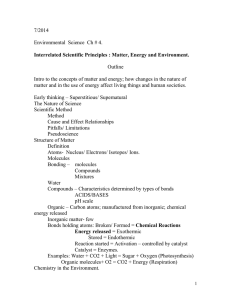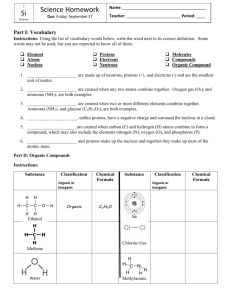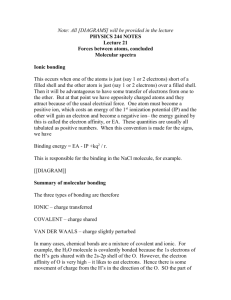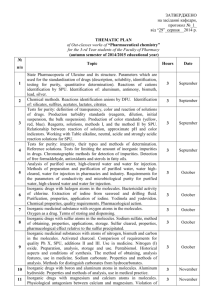ENV Ch 4 Sci. Principles
advertisement
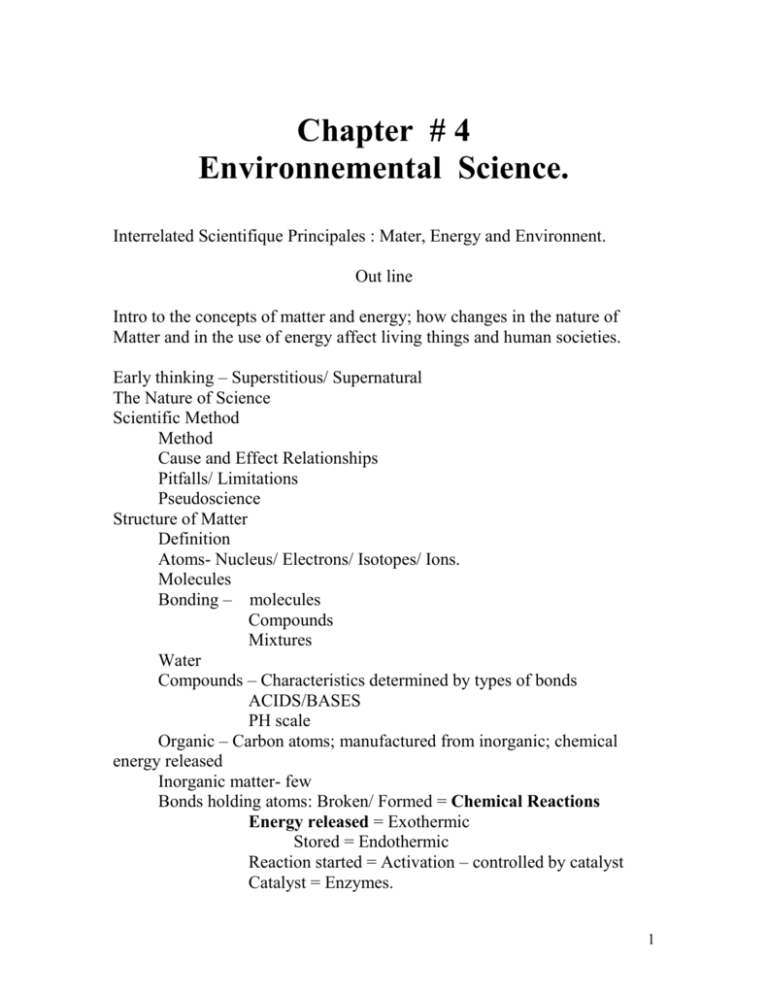
Chapter # 4 Environnemental Science. Interrelated Scientifique Principales : Mater, Energy and Environnent. Out line Intro to the concepts of matter and energy; how changes in the nature of Matter and in the use of energy affect living things and human societies. Early thinking – Superstitious/ Supernatural The Nature of Science Scientific Method Method Cause and Effect Relationships Pitfalls/ Limitations Pseudoscience Structure of Matter Definition Atoms- Nucleus/ Electrons/ Isotopes/ Ions. Molecules Bonding – molecules Compounds Mixtures Water Compounds – Characteristics determined by types of bonds ACIDS/BASES PH scale Organic – Carbon atoms; manufactured from inorganic; chemical energy released Inorganic matter- few Bonds holding atoms: Broken/ Formed = Chemical Reactions Energy released = Exothermic Stored = Endothermic Reaction started = Activation – controlled by catalyst Catalyst = Enzymes. 1 Examples: Water + CO2 + Light = Sugar + Oxygen (Photosynthesis) Organic molecules+ O2 = CO2 + Energy (Respiration) Chemistry in the Environment. Energy Principles Types of Energy States of Matter Sensible heat transfer (Temp changes) Latent heat transfer Laws of Thermodynamics (2) / Implications of Energy Flow. 2 NATURE OF SCIENCE Environmental Science is a relatively new discipline that includes: 1. Applied and theoretical science (The social, Economic and Political aspects). Science – how knowledge is acquired, rather than what is studied. How data are collected and analyzed A process used to solve problems or to develop an understanding of nature. It involves testing possible answers. In order to make responsible environmental related decisions and to appreciate the ecological concepts, it is necessary therefore to understand some chemical and Physical principles. . Basic assumptions in science Scientific Method is a way of getting info by forming possible solutions to questions followed by rigorous testing to determine if the solutions are valid One assumes that the fundamental rules of nature apply regardless of where and when they occur. Cause and Effect Relationships Many events happen at the same time, but not all show a cause and effect relationship. Knowing that a cause and effect relationship exist, enables us to predict what will happen should that same set of circumstances occur in the future Elements of the Scientific Method . 1. Make observations, accurate and unbiased. Question literature. 2. Develop a hypothesis based on observations and information, a logical best guess to explain the observations. 3 3. Test hypothesis by making additional observations or experiment; must be testable to prove a fact. 4. Modify the hypothesis if necessary 5. Prove hypothesis by repeating experiment. Publishing is most important 6. Theory, a broad concept – published. Later a Law, a constant or uniform fact of nature that describes what happens in nature. These steps are not inflexible Theories are broadly written statements. (The word is not always used in the strict scientific sense). Possible Pitfalls Problem definition Data collection Development of a hypothesis. LIMITS to the METHOD Applicable only to science Results are not always correct due to faulty or inadequate data Not suitable for over generalization Not suitable for predictions Conclusions can be used to support both valid and invalid conclusions. PSEUDOSCIENCE. Facts are selected to support a specific point of view. STRUCTURE of MATTER Matter is anything that takes up space and has weight. The best way to describe matter is by using the KINETIC MOLECULAR THEORY, which is that all mater is composed of tiny particles (ATOMS) that are in constant motion. Atomic Structure Atoms are the fundamental subunits composed of PROTONS, NEUTRONS and ELECTRONS. Each atom has a central region, a NUCLEUS. The nucleus consists of 2 types of heavy particles PROTONS (+) and NEUTRONS Clouds of light-weight, fast moving (-) charged ELECTRONS surround the nucleus. 4 The Number of protons, neutrons and electrons in an atom is the difference between elements (92 in all). All atoms of the same element may not have the same number of neutrons, in which case those are ISOTOPES, which have the same # of protons and electrons. Molecular Nature of Matter Atoms bonded together into a stable unit is a molecule, but when different atoms are bonded, a COMPOUND is formed. There are many ways atoms can be combined to form compounds. Mixtures are a combination of atoms or molecules An atom or molecule that has lost or gained one or more electrons is an ION. A Word about Water It covers about 72% of the earth’s surface, influences weather and climate. Present in all living things. Exist in gas, liquid and solid form on earth. It is a di-polar molecule, responsible for its property as a universal solvent Acids, Bases and pH (acetic acid, vinegar, Sulfuric acid) A class of compounds, whose characteristics are determined by the type of bonds . Acids in water release H+ ions. The acids attract negatively charged particles. Bases are the opposite. They release Hydroxyl ions (OH-) in a solution or accept H ions. Sodium Hydroxide or oven cleaner is an example of a base – an alkaline solution. The acid or base strength is represented by a number called its pH, which measures H+ concentration. The number 7 represents a balance between H and OH ions. An increasing number (of H ions) is represented by a smaller pH. Scale is 1 – 14 (Logarithmic and reciprocal) Inorganic and Organic matter. Organic matter contains CARBON atoms, bonded into large molecules (sugar, protein, fat) each of which contains large amounts of chemical energy, released when broken down into inorganic molecules. Inorganic matter composed of small inorganic molecules, are relatively few types (salt, water, Oxygen, and metals). Living things can manufacture organic molecules from inorganic molecules or they can modify organic molecules by consuming organic matter. Chemical Reactions When combined in a molecule, Atoms are held together by chemical BONDS (the interaction between electrons). When the bonds are formed or broken, a CHEMICAL REACTION occurs, at which time energy is released 5 (LOST) as heat or light in an exothermic reaction, or stored in an endothermic reaction. To bond or break apart a molecule, it is necessary to put energy into the system. That energy is ACTIVATION ENERGY. The amount of activation energy is controlled by CATALYSTS. A catalyst is a substance that alters the rate of a reaction, but it is not altered. Chemical reactions in living things Catalysts (in living things) are enzymes. ENZYMES are proteins, which serve to reduce the activation energy needed to start a reaction or to lower the temperature at which the reaction occurs. Example: Photosynthesis is a process in which inorganic material is converted to organic using light energy. Water and Carbon Dioxide are changed to Sugar and Oxygen is released. In RESPIRATION, oxygen is used to break down organic molecules (sugar) into inorganic. (Carbon Dioxide and energy is released). Chlorophyll is responsible for trapping the sunlight energy in the photosynthesis process. Chemistry is extremely important in Environmental problems. (Fertilizers and Pesticides, Smog and Water. Chemistry in the Environment Chemicals are common in the environment. Present in insecticides, (pesticides) and fertilizers. They play a very important role in food production. Organic molecules in water reduce the Oxygen available to living things, ENERGY PRINCIPLES Energy and matter are inseparable. Energy is the ability to do work, move matter over a distance. Kinds of Energy The energy in moving objects is called KINETIC. eg. In air, the molecules are in constant motion 6 POTENTIAL energy is special. It is the energy in an object resulting from the position of the object. Several other types of energy abound. (Heat, light, electrical, chemical). It is possible to convert one form into another. States of Matter The state in which matter occurs depends on the amount of energy in the matter. If the amount of Kinetic energy is changed, the physical nature of the matter changes. The CHEMICAL nature stays unchanged. Eg. Water. Sensible heat transfer: when two objects placed next to each other, the cool object becomes warm and the hot one gets cooler. Latent heat transfer: When heat energy is used to change the state of matter, heat is transferred, but the Temperature of the object does not change. Laws of Thermodynamics 1. Energy cannot be created or destroyed. It can only be converted from one form to another. 2. There is no loss in total energy in conversion, but there is some loss in useful energy. The energy that cannot be used to do useful work is called entropy. Entropy increases on converting energy. ENVIRONMENTAL IMPLICATIONS of ENERGY FLOW. Energy Entropy : When energy is converted, the lost energy is dissipated into the universe (entropy) Energy Quality: Some forms of energy are high quality (electricity) and others are of low quality. Eg. Heat in Ocean waters. Biological Systems and Thermodynamics : All organisms are in the process of converting energy, low to high, but quantity stays the same. Pollution and Thermodynamics : Chemical energy in food is converted to be used in growth or to do work- respiration. This is similar to combustion. 7 The consequence of energy conversion is POLLUTION. The heat lost is waste, a pollutant. 8
